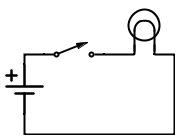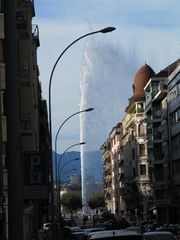Electric circuits, volts amps watts and ohms: Difference between revisions
| Line 40: | Line 40: | ||
==Watts - feel the power== | ==Watts - feel the power== | ||
Volts x Amps - large voltage ''or'' large current. | (Summary: Volts x Amps - large voltage ''or'' large current. Illustrations?) | ||
If you need a lot of power, for instance to drive a train, you can get it either by increasing the voltage (pressure), or the current (flow). Or both. | |||
Doubling the voltage but keeping the same current doubles the power, and so does doubling the current at the same voltage. So if we multiply the volts by the amps we get the power in watts: | |||
'''Watts = Volts x Amps''' | |||
Trains running through London on the Thameslink line take their power from overhead lines at 25,000V on the North installed in the 1980's, but use an older third rail system delivering the same power at 750V to the South. The higher voltage means much less current is needed, and so much thinner wires can be used. A high voltage couldn't be used on a third rail as it's only a few inches from the running rails and would be extremely dangerous for anyone falling onto the track. However, the third rail has a large cross sectional area and so an carry a heavy current. | |||
Mains electricity is delivered at 240V. A plug fitted with a 3A fuse is therefore suitable for appliances up to 240 x 3 = 720W. A 13A fuse is good up to 240 x 13 = 3120W. | |||
Turning the formula around, you can divide the watts by the volts to get the amps. A 1000W appliance therefore takes 1000 / 240 = 4.167A, so a 5A fuse would do nicely. | |||
==Ohms - resistance isn't futile== | ==Ohms - resistance isn't futile== | ||
Revision as of 21:29, 23 November 2014
Basic electrical theory every Restarter should know.
(This page is work in progress - comments and update suggestions to the Discussion page only for now please.)
Summary
A knowledge of basic electrical theory is essential for anything more than purely mechanical repairs, and will greatly help in diagnosing faults and working safely.
Electrical Circuits - doing the rounds
An atom consists of a very dense nucleus carrying a positive electric charge surrounded by a cloud of electrons, each having a negative electric charge. Normally, the positive and negative charges cancel exactly. Positive and negative charges attract one another, which is what keeps the electrons bound in an atom. Conversely, like charges repel.
In a metal, some of the electrons are not bound to any particular atom but are free to wander off. Nevertheless, the total of the positive and negative charges remain equal in the lump of metal as a whole. If these electrons move in a steady stream in one direction, e.g. along a piece of wire, we have an electric current.
Since electrons all have a negative charge they repel each other and hence they really hate piling up. So unless they can all move together around a complete circuit and back to where they started, they immediately back up at any obstruction all the way back round the circuit to the other side of the blockage.
The figure shows a very simple circuit consisting of a battery, a switch and a torch bulb. The switch is shown open and so no electricity can pass through it, so none flows anywhere in the circuit. If you close the switch and so complete the circuit, an electric current can flow from one side of the battery, through the switch and the bulb, and back to the other side of the battery.
Electrons carry a negative charge and so are repelled by the negative terminal of the battery and attracted around the circuit to towards the positive terminal. However, in explaining a circuit we often talk about the electricity flowing from positive to negative. Indeed, sometimes an electric current does consist of positively charged atoms moving from positive to negative. Positive to negative or negative to positive, it makes no difference. Whichever best helps you to understand a circuit is the one to use.
Volts - the pressure is on
(Summary: Low pressure - pic: thumb over inverted bottle of water? High pressure - pic: Geneva Jet d'Eau.)
Voltage is like the electrical pressure. If you put your thumb over the bathroom tap and turn it on, you can probably stop the flow because you're only holding back the pressure of the water from the tank in the loft a few feet above your head. If you try the same at the kitchen tap, probably fed directly off the water main, you're likely to get very wet because the pressure is much higher. The Jet d'Eau at Geneva uses an enormous pressure to create a fountain several hundred feet high. Imagine trying to stop that with your thumb!
In the circuit we looked at above the current is driven round the circuit by a battery. That might be an AA cell, which doesn't push very hard. We measure the pressure in volts, of which an AA cell will give us around 1.5, and so it will be labelled 1.5v. If you replaced the battery in our circuit by a source of a few thousand volts, the pressure would be so great that the electricity would form a spark in order to jump over the open switch. And the bulb probably wouldn't last long either!
Mains electricity comes at 240v, which is enough to do useful work but not so much as to jump across a switch or break out anywhere else it's not meant to go.
Amps - go with the flow
(Summary: Small flow - pic: dripping tap? Large flow - pic: Amazon?)
As well as the pressure (voltage), we'll also be interested in how heavy is the flow of electricity, i.e. just how many electrons pass a given point per second. This is the current, measured in amps. Remember, since electrons don't like piling up, it's got to be the same at any point around a simple circuit.
Again, we can use the analogy of water. A dripping tap represents a very small flow - it might take hours to fill a litre jar. The Amazon, on the other hand discharges around 200 million litres per second into the sea. A small solar cell like the ones on solar garden lights can only produce perhaps a few hundredths of an amp of current, but a car battery might deliver 100 amps (written 100A) to turn the starter motor.
Just as you need a fat pipe to supply water to a whole town, so you need fat wires to carry a heavy current. The wires connected to a car battery are much thicker than most other wires you're familiar with.
Watts - feel the power
(Summary: Volts x Amps - large voltage or large current. Illustrations?)
If you need a lot of power, for instance to drive a train, you can get it either by increasing the voltage (pressure), or the current (flow). Or both.
Doubling the voltage but keeping the same current doubles the power, and so does doubling the current at the same voltage. So if we multiply the volts by the amps we get the power in watts:
Watts = Volts x Amps
Trains running through London on the Thameslink line take their power from overhead lines at 25,000V on the North installed in the 1980's, but use an older third rail system delivering the same power at 750V to the South. The higher voltage means much less current is needed, and so much thinner wires can be used. A high voltage couldn't be used on a third rail as it's only a few inches from the running rails and would be extremely dangerous for anyone falling onto the track. However, the third rail has a large cross sectional area and so an carry a heavy current.
Mains electricity is delivered at 240V. A plug fitted with a 3A fuse is therefore suitable for appliances up to 240 x 3 = 720W. A 13A fuse is good up to 240 x 13 = 3120W.
Turning the formula around, you can divide the watts by the volts to get the amps. A 1000W appliance therefore takes 1000 / 240 = 4.167A, so a 5A fuse would do nicely.
Ohms - resistance isn't futile
Volts per amp
Illustration?
Safety
Consider whether your page should include a specific section on safety, if for example it deals with mains-powered equipment or high voltages, or if special care is required in handling hot or sharp tools, or hazardous substances.
References
External links
- External links as bullet points


